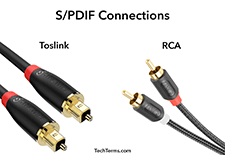S/PDIF
Stands for "Sony/Philips Digital Interface" (and is pronounced "spid-if"). S/PDIF is a digital audio transmission standard for transferring audio between two devices. It is uni-directional (one-way) and supports uncompressed stereo audio and compressed surround sound audio.
A S/PDIF audio signal may be transmitted over coaxial or fiber optic cable. Coax transmissions use RCA connectors, while optical transmissions use Toslink connectors. Regardless of the transfer medium, a S/PDIF signal is always digital, not analog.
S/PDIF supports uncompressed 2-channel (stereo) audio, making it an ideal interface for CD players, turntables, and other stereo audio devices. While S/PDIF supports surround sound signals, it does not have enough bandwidth to transmit more than two channels of uncompressed digital audio. Therefore, S/PDIF must transfer 5.1 and 7.2 surround sound audio in a compressed format, such as Dolby Digital. Specifically:
S/PDIF Supports:
- 2-channel uncompresed 16-bit, 44.1 kilohertz stereo audio
- Compressed surround sound audio (Dolby Digital, DD+, and DTS)
S/PDIF Does Not Support:
- More than two channels of uncompressed audio
- Uncompressed surround sound audio (Dolby TrueHD and DTS-HD Master Audio)
Uncompressed surround sound audio requires a high-bandwidth digital connection, such as HDMI or ADAT.
 Test Your Knowledge
Test Your Knowledge